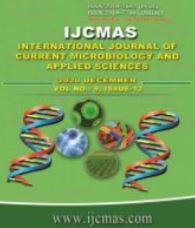


 National Academy of Agricultural Sciences (NAAS)
National Academy of Agricultural Sciences (NAAS)

|
PRINT ISSN : 2319-7692
Online ISSN : 2319-7706 Issues : 12 per year Publisher : Excellent Publishers Email : editorijcmas@gmail.com / submit@ijcmas.com Editor-in-chief: Dr.M.Prakash Index Copernicus ICV 2018: 95.39 NAAS RATING 2020: 5.38 |
Mango (Mangifera indica Linn.) is the “king of fruits” originated from South East Asia. Mango is affected by many biotic stresses; among them dieback is one of the serious diseases incited by the fungus Lasiodiplodia theobromae. Roving survey conducted in Tamil Nadu revealed the maximum disease incidence of 55.84% in Mulaiyur village (ILtDM10) of Dindigul district and minimum disease incidence of 8.95% in Ettipatti village (ILtDM17) of Krishnagiri district, Tamil Nadu. Major symptoms observed were defoliation of infected leaves, tip dieback, bark, twigs drying, shrivelling of twigs, vascular discolouration, and finally death of plants. Thirty numbers of pathogen isolates were collected from the diseased plant parts collected during the survey and pure cultures of them were established. The morphological characteristics of the pure cultures were studied and the pathogen growth was initially white, later on grey to dark greyish black with black to dark black pigmentation. Conidia were initially hyaline, unicellular, sub ovoid to ellipsoid and mature conidia were dark brown to black, bi-celled, ellipsoid, thick walled with longitudinal striations. The size of the conidia varied between 18.4 - 26.8 × 10.6 - 14.2 µm.
 |
 |
 |
 |
 |